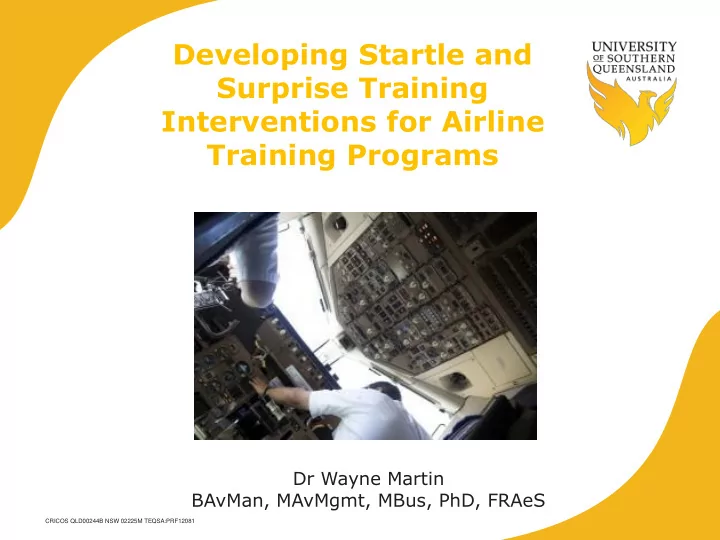

Developing Startle and Surprise Training Interventions for Airline Training Programs Dr Wayne Martin BAvMan, MAvMgmt, MBus, PhD, FRAeS CRICOS QLD00244B NSW 02225M TEQSA:PRF12081
The Problem with Startle and Surprise Surprise An unexpected event that violates a pilot’s expectations and can affect the mental processes used to respond to the event (FAA, 2015) CRICOS QLD00244B NSW 02225M TEQSA:PRF12081
The Problem with Startle and Surprise Two Types of Surprise - Fundamental Surprise - Situational Surprise CRICOS QLD00244B NSW 02225M TEQSA:PRF12081
The Problem with Startle and Surprise Startle An uncontrollable, automatic muscle reflex, raised heart rate, blood pressure, etc., elicited by exposure to a sudden, intense event that violates a pilot’s expectations. (FAA, 2015) CRICOS QLD00244B NSW 02225M TEQSA:PRF12081
The Problem with Startle and Surprise Colgan Air – Buffalo 2009 CRICOS QLD00244B NSW 02225M TEQSA:PRF12081
The Problem with Startle and Surprise Turkish Airlines – Amsterdam 2009 CRICOS QLD00244B NSW 02225M TEQSA:PRF12081
The Problem with Startle and Surprise Air France – Atlantic Ocean 2009 CRICOS QLD00244B NSW 02225M TEQSA:PRF12081
The Problem with Startle and Surprise Pinnacle Airlines – Jefferson City 2004 CRICOS QLD00244B NSW 02225M TEQSA:PRF12081
The Problem with Startle and Surprise West Caribbean Airlines – Venezuela 2005 CRICOS QLD00244B NSW 02225M TEQSA:PRF12081
The Problem with Startle and Surprise Air Asia – Indonesia 2014 CRICOS QLD00244B NSW 02225M TEQSA:PRF12081
A Conditioned Expectation of Normalcy While Pilots may practise emergencies in the sim for perhaps four days a year, the remainder of the 360+ days are often routine and emergency-free. On those rare occasions when things do go wrong, then a lack of expectation can produce some heightened surprise and stress reactions, with negative effects on situation outcome. CRICOS QLD00244B NSW 02225M TEQSA:PRF12081
The Problem with Startle and Surprise The FAA Experiments – A powerful example CRICOS QLD00244B NSW 02225M TEQSA:PRF12081
Training Interventions CRICOS QLD00244B NSW 02225M TEQSA:PRF12081
Training Interventions Simulator experiments are being conducted to expose pilots to ‘controlled’ interventions. CRICOS QLD00244B NSW 02225M TEQSA:PRF12081
Training Interventions Pilot Briefing Package CRICOS QLD00244B NSW 02225M TEQSA:PRF12081
Training Interventions CRICOS QLD00244B NSW 02225M TEQSA:PRF12081
Training Interventions Immediate Action Events EGPWS Terrain Warning Rejected Takeoff Reactive Windshear Recognition (Impending) Stall Warning Primed Reactions Aircraft Upset (Overlearned) Cabin Altitude TCAS RA CRICOS QLD00244B NSW 02225M TEQSA:PRF12081
Training Interventions Non-immediate Action Events 1. Take a few seconds to recover if possible 2. Check and call the aircraft state – Speed, Alt, Pitch, EICAS/ECAM 3. Decide on the best course of action A 3 step process: B - Breathe (Pause) A - Analyse D - Decide CRICOS QLD00244B NSW 02225M TEQSA:PRF12081
Training Interventions Simulator Exercises Simulator exercises which incorporate startle/surprise event training must be very carefully managed to avoid negative training. It is quite possible that poorly conducted training could actually have negative consequences during future unexpected critical events. It is critical that pilots leave the sim with a sense of self-efficacy for managing such events. CRICOS QLD00244B NSW 02225M TEQSA:PRF12081
Training Interventions Simulator Exercises The utility of startle/surprise exercises will vary between simulators. The use of distraction immediately prior to an event is recommended to add to the surprise effect. CRICOS QLD00244B NSW 02225M TEQSA:PRF12081
Training Interventions Simulator Exercises - Examples Forward Cargo Door Blowout with Associated Engine Failure • Unexpected Stick Shaker Stall warning • Unexpected EGPWS Terrain warning (Glass Mountain) • Autothrottle Failure during Level Off in Climb or Descent (with • distraction) Failure of PF Autopilot Disconnect on RNAV GNSS Approach • Subtle Autopilot Failure during Level Off in descent (with • distraction) Altitude Capture Failure • Dual AC Bus Failure at 500 feet on Approach • Compressor Stall during Go Around • CRICOS QLD00244B NSW 02225M TEQSA:PRF12081
Training Interventions CRICOS QLD00244B NSW 02225M TEQSA:PRF12081
Training Interventions Behavioural Marker Assessment CRICOS QLD00244B NSW 02225M TEQSA:PRF12081
Training Interventions Behavioural Marker Assessment CRICOS QLD00244B NSW 02225M TEQSA:PRF12081
Training Interventions Behavioural Marker Assessment CRICOS QLD00244B NSW 02225M TEQSA:PRF12081
Training Interventions Behavioural Marker Assessment CRICOS QLD00244B NSW 02225M TEQSA:PRF12081
Training Interventions Behavioural Marker Assessment CRICOS QLD00244B NSW 02225M TEQSA:PRF12081
Training Interventions Summary While uncommon, the negative effects of startle and surprise have the potential to adversely affect safety, particularly during unexpected critical events UPRT training, which is being rolled out around the world may incorporate startle and surprise exercises, however the potential for negative training is significant. Conduct of such exercises is critical and needs to be carefully considered, constructively run, and leave pilots with a greater sense of self-efficacy. CRICOS QLD00244B NSW 02225M TEQSA:PRF12081
Questions? CRICOS QLD00244B NSW 02225M TEQSA:PRF12081
Recommend
More recommend